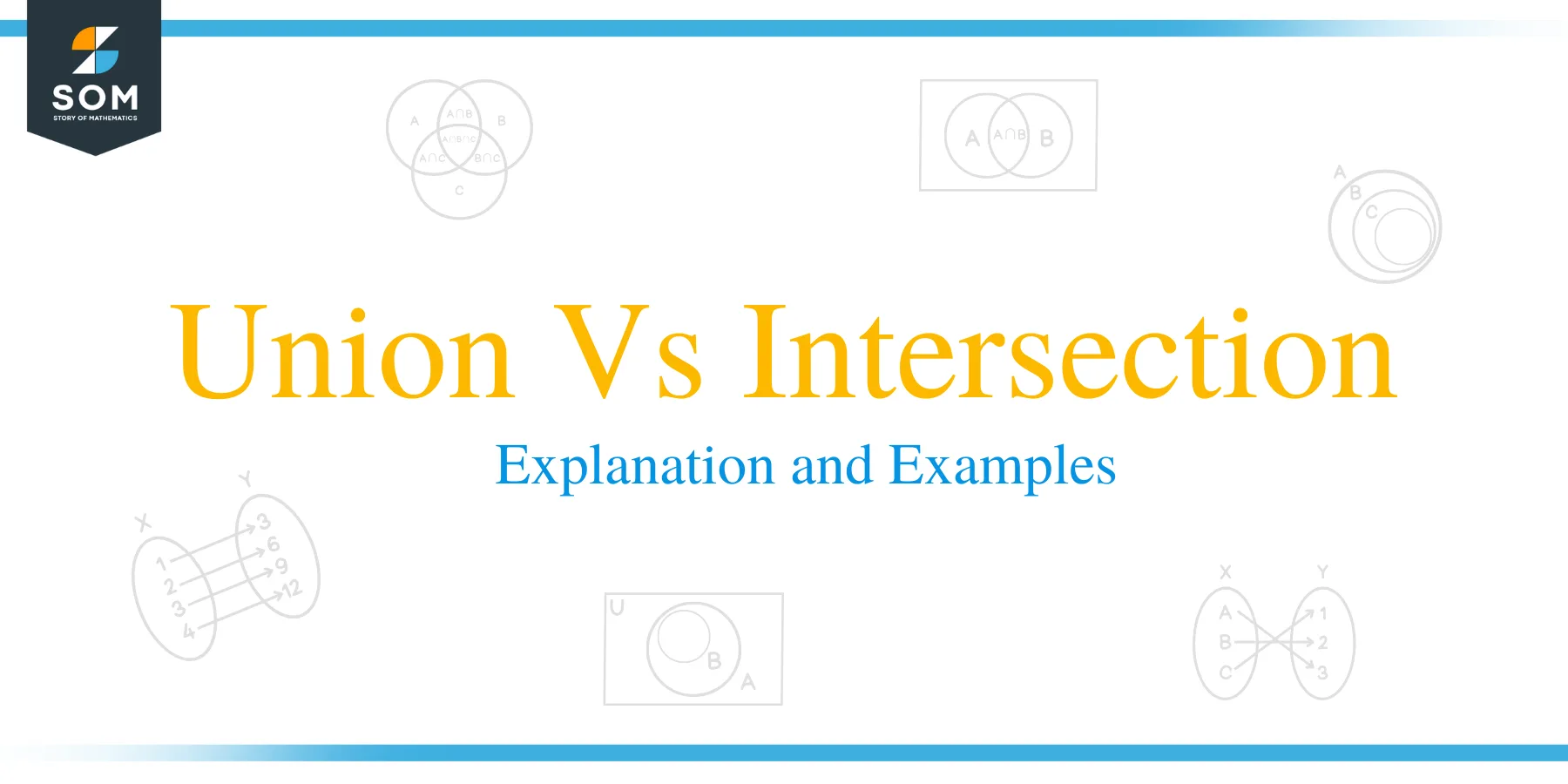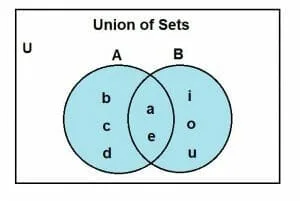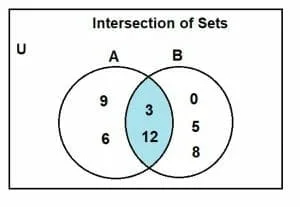- Home
- >
- Union vs intersection – Explanation and Examples
JUMP TO TOPIC
Union Vs Intersection – Explanation and Examples
 In sets and set theory, two of the most fundamental concepts are set union and set intersection. These two concepts build the foundation of sets and give birth to the pictorial representation of sets in Venn diagrams. The battle between union and intersection is a prolonged one that can only be understood by strengthening our concept of set union and set intersection.
In sets and set theory, two of the most fundamental concepts are set union and set intersection. These two concepts build the foundation of sets and give birth to the pictorial representation of sets in Venn diagrams. The battle between union and intersection is a prolonged one that can only be understood by strengthening our concept of set union and set intersection.
The union of sets is the joint set that contains the elements of all the sets, whereas, the intersection of sets is the set containing only the common elements present among sets.
This article will be taking a recap of the concept of set union and set intersection as we have already covered these topics in detail in our previous articles. We will also be conducting a head-on head comparison of set union and set intersection.
In this article, we will be covering the following topics:
- What is the union of sets?
- Venn diagram representation of the union of sets.
- What is the intersection of sets?
- Venn diagram representation of the intersection of sets.
- Union Vs intersection.
- Examples.
- Practice problems.
Before moving forward, you may consider refreshing your knowledge on the following prerequisites:
What is the Union of Sets?
Whenever we encounter any problem related to sets, the two most widely applied operations are set union and set intersection. In this section, we will be going over the concept of the union of sets.
The set union is defined as merging two sets such that the new set contains all the elements presented individually in the two sets. We can also say that the union of the set is a set that contains both the elements present in the first set and the second set.
To further understand the union concept, consider the following example.
Example 1
Consider the following two sets:
A = {1, 2, 3}
B = {3, 4, 5}
Find their union.
Solution
The union of the set is a new set that contains all the elements of the individual sets. The union of these two sets, A and B, will include the elements {1, 2, 3, 4, 5}.
Notation for Set Union
For every operation in set theory, a special notation is specified for each operation. The same is the case with the set union. To indicate the union between two sets, the symbol ‘U’ is used. This symbol is the notation for the set union between any two or more sets.
Consider two sets, A and B. The union for these sets is given as:
A U B
We can extend the union operation to a group of sets containing more than 2 sets. Consider four sets, namely A, B, C, and D. The union for these four sets is given as:
A U B U C U D
Let’s consider an example regarding the set union.
Example 2
Consider the following sets:
A = {3, 4, 5}
B = {2, 4, 6}
C = {3, 6, 9}
Find their union.
Solution
The union of these three sets is given as:
A U B U C
Finding the union:
A U B U C = {3, 4, 5} U {2, 4, 6} U {3, 6, 9}
A U B U C = {3, 4, 5, 2, 6} U {3, 6, 9}
A U B U C = {3, 4, 5, 2, 6, 9}
This indicates the union of the three sets A, B, and C.
Venn Diagram Representation of the Set Union
Set Union is the operation that shows the combined elements of all the sets. Let’s take two sets, A and B, to represent set union via Venn diagrams.
Let A = {a, b, c, d, e} and B = {a, e, i, o, u}. The union of these two sets, A and B, will contain all the elements individually. Their union is given as follows:
A U B = {a, b, c, d, e, i, o, u}
We can represent the set union through Venn diagrams. After representing each set with a circle and enclosing them in the universal rectangular set, their union can be depicted by shading A and B regions. For more information on the universal set, consider our previous topic, ‘Universal Set.’
To understand this, let’s take sets A and B. We know that their union is as follows:
A U B = {a, b, c, d, e, i, o, u}
To represent this with a Venn diagram, we will use two circles, one for set A and one for set B. the universal set U, in this case, is the set of alphabets to which both sets A and B would belong to. Following is the Venn diagram representation of the union:

The entire region shaded in blue shows the union of the two sets, A and B. Although the overlapping still exists in the Venn diagram, the overlapped region will also be shaded in the same color as the two sets to indicate the union.
Following is an example related to this concept.
Example 3
Consider a set A = {3, 6, 9, 12} and set B = {0, 3, 5, 8, 12}. Show the union of A and B through Venn diagram. Let set U = {set of whole numbers till 20}.
Solution
The union of the two sets A and B is given as:
A = {3, 6, 9, 12}
And,
B = {0, 3, 5, 8, 12}
So the union is:
A U B = {0, 3, 5, 6, 8, 9, 12}
This union can be depicted through the Venn diagram as follows:

What is the Intersection of Sets?
Now that we have covered the set union let’s move onto the second topic about the intersection of sets.
The intersection of sets is used to indicate the common elements shared by two or more sets. In other words, we can say that the set that represents the intersection of sets includes the elements that belong to any set A but are also a part of any set B. So, we can conclude that the intersection of sets indicates the common elements between the sets.
The concept of intersection is not only restricted to two sets. We can also extend it to three, four, or more sets.
To understand the intersection of sets, consider the following example.
Example 3
Consider the following sets:
A = {2, 4, 6}
B = {3, 6, 9}
Find the intersection of these two sets.
Solution
The intersection indicates the common elements shared by the two sets. Upon analyzing, the common element shared by these two sets is only one, and that element is 6. So the intersection of sets A and B is {6}.
Notation for Set Intersection
Set intersection is an important concept in set theory. Therefore, it deserves a proper notation. The symbol ‘∩’ is used to indicate the intersection between sets. This symbol indicates the intersection between any two sets, say A and B.
Consider any two sets, A and B. Their intersection is given as:
A ∩ B
The concept of intersection is not restricted to only two sets. It can extend to a group of sets. Consider a group of sets containing the sets A, B, C, and D. The intersection between these sets is given as:
A ∩ B ∩ C ∩ D
Let’s solve an example related to the intersection of sets.
Example 4
Consider the following sets:
A = {2, 4, 6}
B = {3, 6, 9}
C = {6, 12}
Find their intersection.
Solution
The intersection of these three sets is given as:
A ∩ B ∩ C
It can be evaluated as,
A ∩ B ∩ C = {2, 4, 6} ∩ {3, 6, 9} ∩ {6, 12}
A ∩ B ∩ C = {6}
This represents the intersection between the three sets A, B, and C.
Venn Diagram Representation of Set Intersection
Set intersection is the operation that shows common elements between sets. For example, if A = {a, b, c, d, e} and B = {a, e, i, o, u}, then their intersection is as follows:
A ∩ B = {a, e}
Where ‘a’ and ‘e’ are the only two common elements between sets A and B.
We can represent the set intersection through Venn diagrams as well. After representing each set with a circle and enclosing them in the rectangular universal set, their intersection can be depicted through the two circles’ overlapping.
To understand this better, let’s consider the above sets A and B. We determined the intersection between these sets A and B, which is as follows:
A ∩ B = {a, e}
To represent them with a Venn diagram, we will use two circles, one for set A and one for set B. the universal set U, in this case, is the set of alphabets to which both sets A and B would belong to. Following is the Venn diagram representation of the intersection:

The shaded blue area represents the intersection between A and B.
Following is an example related to this concept.
Example 5
Consider a set A = {3, 6, 9, 12} and set B = {0, 3, 5, 8, 12}. Show the intersection between A and B through Venn diagram. Let set U = {set of whole numbers till 20}.
Solution
The intersection between the two sets A and B can be determined as:
A = {3, 6, 9, 12}
And,
B = {0, 3, 5, 8, 12}
The intersection is:
A ∩ B = {3, 12}
The Venn diagram representation for the intersection between sets A and B is:

Union Vs Intersection
Now that we have covered the concepts of set union and set intersection, let’s move onto their comparison. To compare two of the most fundamental set operations, we will look at the properties shared by these two operations. For that, we will consider any finite set, namely A, and we will drive its relations with the empty set 𝛟.
Union:
The union of any finite set A with an empty set will always set A itself.
It can be depicted as follows:
A U 𝛟 = A
Intersection:
The intersection of any finite set A with an empty set will always result in an empty set 𝛟.
It can be depicted as follows:
A ∩ = 𝛟
Let’s solve an example constituting both these operations.
Example 6
Consider a set A = {1, 2, 3, 4, 5}. Drive the relations of this set A with an empty set 𝛟.
Solution
The relation of any finite set with an empty set can be portrayed through two vital set operations; set union and set intersection.
The union is given as:
A U 𝛟 = {1, 2, 3, 4, 5} U 𝛟
A U 𝛟 = {1, 2, 3, 4, 5}
A U 𝛟 = A
Similarly, the intersection is given as:
A ∩ 𝛟 = {1, 2, 3, 4, 5} ∩ 𝛟
A ∩ 𝛟 = 𝛟
A ∩ 𝛟 = 𝛟
To further strengthen the concept of union vs intersection, consider the following practice problems.
Practice Problems
- Find the union of the sets {22, 33, 44, 55} and {66, 44, 22}.
- Find the intersection of the sets {3, 5, 6, 7}, {3, 5}, {2, 1}.
- Show the Venn diagram representation of the above sets.
- Consider a finite set A = {set of alphabets}. Drive the relations of this finite set with an empty set.
- Let A = {x : x is a multiple of 5 till 45}. Find its union and intersection with an empty set.
Answers
- {22, 33, 44, 55, 66, 22}
- Null set
- A, ⲫ
- A, ⲫ
